I’d like to welcome my dear friend Deepa of Paticheri who is a dedicated follower of Meyers, like some people I know! Deepa has done so much to bring my love of Meyers to life, showing me how to grow Meyers from seed and providing the sprouted seeds for my planting. In addition, I absolutely adore her illustrations.
I first met Deepa ‘virtually’ in 2011, when she commented on my ‘Spiced Pumpkin Churros‘ post. It turns out she spent many years of her childhood in my very same home country of Nigeria. I was totally bowled over, because not only did she grow up in Nigeria, but also because she wanted to write about one of my favourite ever snacks, puff-puff.
Deepa writes: ‘I chanced on your beautiful site while searching around for any commentaries on puff puffs that might be out there, for a blog I write. I grew up in Kano, and on puff puffs (unbeknownst to my parents, who forbade “outside food” as a matter of course). Just wanted to say here that your post was beautiful, the writing just perfectly sugared and crisp and warm, much like the churros themselves. I’m a repat, too, though not to Kano, but to India. It’s lovely to see narratives like yours out there, in parallel to the ones I’m living and trying to write about. Anyway, I look forward to staying in touch.
After reading Deepa’s puff-puff post, I was struck by how incisive, instructive, engaging, humourous and emotive her writing is. It took one post for me to feel like I had found a sister. And the die for this friendship, this sisterhood was cast.
And then she showed herself true in loving Meyers as much as I do.
Deepa’s blog, Paticheri is a wonderful showcase of her many parts – cultural anthropologist, college professor, mother, wife, writer and totally wonderful illustrator/graphic designer!
Her hope for ‘Pâticheri…… that it becomes a site for such narration, a celebration of food in all its messy, difficult, gastronomical ethno.graphic richness‘ is lived out every time she writes a post.
Thank you Deepa, for agreeing to share not only Indian culture with us, but a view of the Meyer as a cure-all, not only mentally with its heady scents, but also flavourfully!
—–00000—–
When Ozoz asked me to come up with a guest post on Meyer lemons, I thought to myself: sure, that’s easy. There’s nothing easier than writing passionately about the things one loves the most in life, and Meyers fall easily into that category. Right?
Think again.
Trouble is, I’m hardly alone in my expression of unabashed devotion to Meyers. To have swooned at their sweet fragrance and delighted in their generous juiciness. To have marvelled at the way they’d all turn from green to luminous yellow after the first Houston frost–like globular lights turning on, signalling southern Christmastime.
I’m not alone in my crazed stuffing of already overfull backpacks with ripening lemons to convey them great distances on the simple faith that it is a sin to waste a Meyer. Nor in my desperation to retain access to these rare lemons by growing them from seed, even if it means waiting a whole eight years, and battling through seasons and salt water winds, and bugs and vermin of all kinds, in order to hope–just hope–for one more ripe fruit.
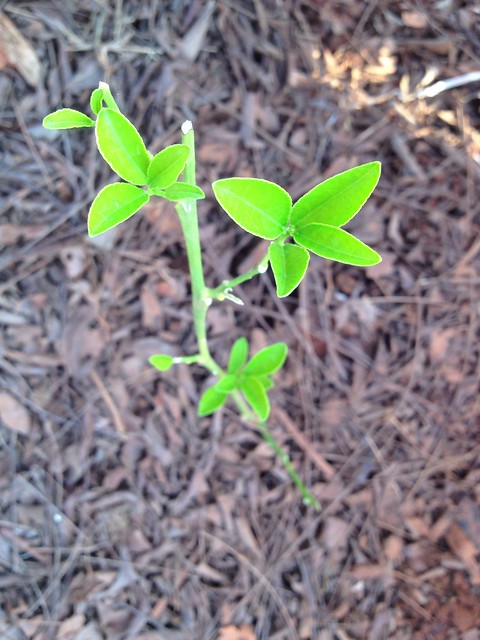
SaplingI’m certainly not alone in knowing, somewhere in my bones and at the base of my tongue, that what Meyers bring to the dishes they grace are not to be compared to anything else in this world.
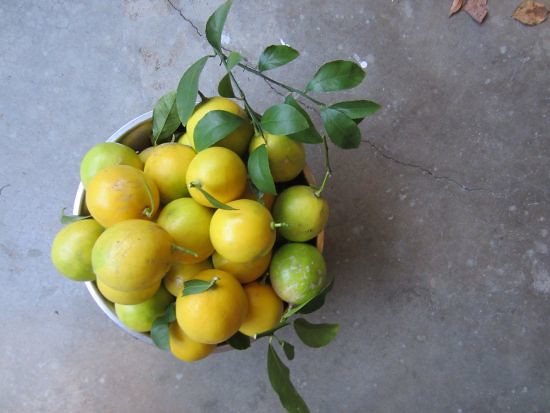
Those of us who’ve thought these things and experienced these things and done these things belong to a tribe all our own. We don’t meet often. We may not even know of each-others’ existence. But we will recognize each-other at once, through our mutual dedication to the Meyer.
[A bit like those chocolate lovers out there, who will group together in degrees, as milk or 70% cacao types].
What to say to this tribe that hasn’t already been said? The beloved Meyer has already been tarted, curded, roasted, cordialed, and baked upside-down. What other essence could there possibly be left to extract? I was stumped.
I was also, as it happened, dog sick. After a full week of non-stop days and relentless deadlines, my body just caved. Convalescing on the couch, I found myself thinking of Meyers as medicinal rather than indulgences. The 20th cup of honey-lemon-ginger tea warming my hands, I found myself wishing for something less sweet. I found myself dreaming of rasam.
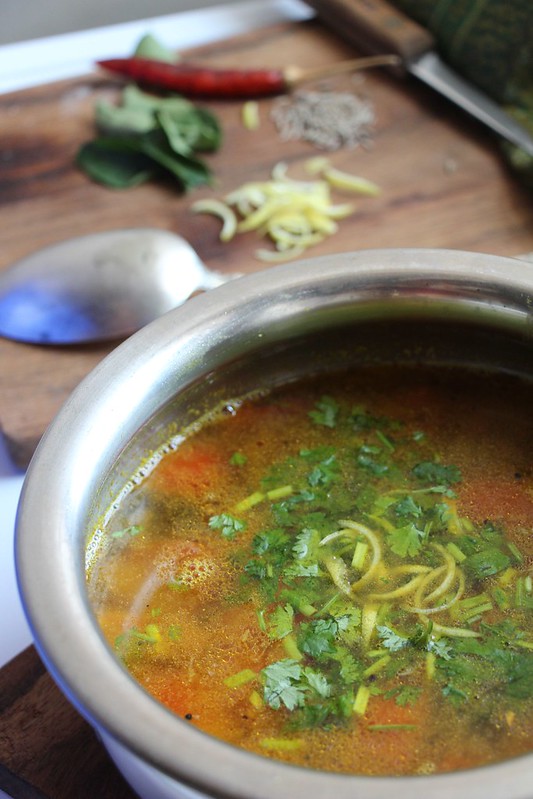
“Rasam” probably deserves a post (or two) of its own to really do it justice – but for now, a quick overview so as to connect the dots to the Meyer lemon.
Rasam as a dish is basically a clear soup prepared with a few select ingredients and eaten with rice. It’s an essential component of the South Indian meal, but can also be had on its own as a drink. Fantastically soothing and lightly nutritious, it’s perfect for convalescents – a sort-of vegan equivalent to chicken soup. Its variations are endless: rasam can be made with or without dal, with or without tomatoes, with or without tamarind, with or without black pepper and cumin, with or without green chillies, with or without jaggery (raw palm sugar), with or without ginger, with or without garlic, with or without a spice powder. It can be deeply complex, or surprisingly simple.
Are you with me still? Or without? [grinning widely]
It’s difficult to explain what rasam positively is, beyond a “broth.” To go farther, we need a brief primer in Indian aesthetics. Yes, there is a connection, if you’ll bear with me.
Rasa in Sanskrit means juice or essence. As a theory of aesthetics, it refers to emotional states in their most distilled form–so we speak of the navarasas, or the nine rasas: Love (Śṛngāram/शृङ्गारं), mirth or happiness (hāsyam/हास्यं), raudram (anger/ रौद्रं), compassion (kāruṇyam/कारुण्यं), disgust (bībhatsam/बीभत्सं), fear (bhayānakam/ भयानकं), (vīram/वीरं), and wonderment (adbhutam/अद्भुतं). Not all these emotions are expressed together, of course; some are given greater play at certain moments in life, and we usually know what combination is at work at any given time.
The rasa theory of aesthetics carries over into culinary arts in the form of rasam. The dish is a distillation of the juice or essence of tomato, or lemon, or ginger, or black pepper, or even the oddest of vegetables that is the “drumstick” – made possible by aligning it precisely amidst a constellation of other ingredients such that its taste comes across exactly, and powerfully.
But wait, you’re thinking, you need all these other ingredients to make the taste of lemon come through? Why not just the juice? or the essential oil?
But it’s funny, isn’t it – that for us to really be able to grasp, to experience on our palates, to revel in the quintessence of anything, we need to know as much what it is, as what it’s not. And that we often know what feelings and tastes and ideas definitively are, by pinning down what they’re not. Rasam does that for its star ingredient, in this case the Meyer lemon: it distils essence by setting up a play of contrasts.
Since the precise taste of tamarind or lemon or tomato varies by the batch, rasam varies, too. Our mothers were masters at figuring out these variations and distilling essences to soothe our souls daily, with no culinary school or cookbook to teach them precisely how. Knowing how to work with tastes at this most basic level, getting a feel for spices and tastes so that you can choreograph a ballet in which one precise taste comes shining through at will and on demand – for me, this is the source of some real culinary finesse.
In my case, with my mother far away, and my condition and craving as it was, the task at hand was to set a stage on which the essence of the Meyer lemon, its precise rasa, could come shining through. And soothe my nose and throat and throbbing head, while at it.
Basic ingredients: ginger, turmeric, green chillies, fresh coriander, and of course Meyer lemon juice and zest [that last gets sprinkled as a garnish].
The same ingredients with the addition of rice, peanuts, and a few dry lentils, would make a nice batch of lemon rice, I decided. Lemon paired with lemon should have signalled overkill, but I could think of nothing but a jubilant celebration of lemon-ness on the one hand, and the solid, natural dose of Vitamin C I’d be getting, on the other.
The essence of the Meyer in two acts.
—–00000—–
Thank you Deepa. I am sooooooooooo looking forward to making both Rasam soup and Lemon Rice. Both look and sound stunning.
Visit Deepa’s wonderful blog at Paticheri.
[wpurp-searchable-recipe]Guest Post on Meyers: Living with Lemons – – – [/wpurp-searchable-recipe]

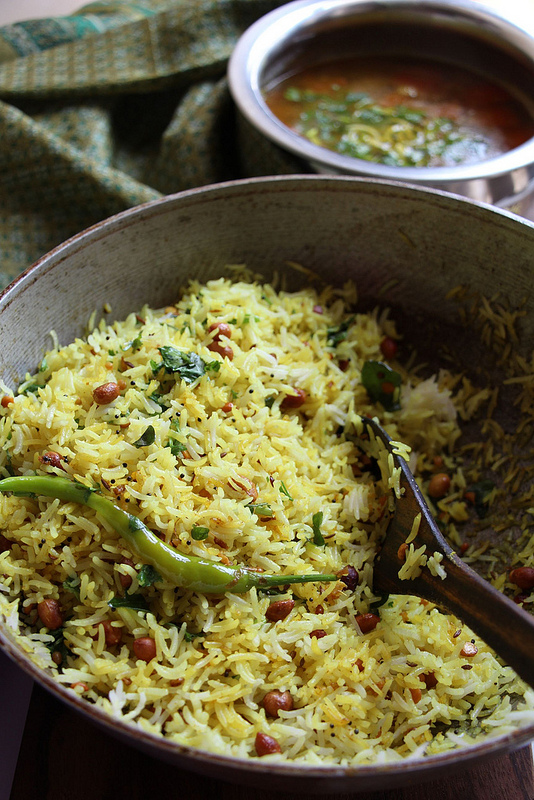

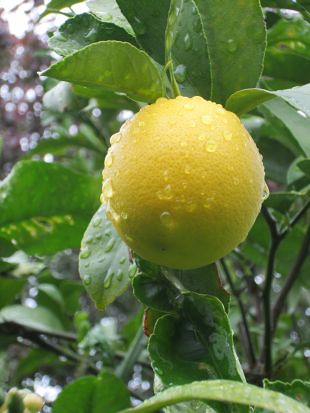
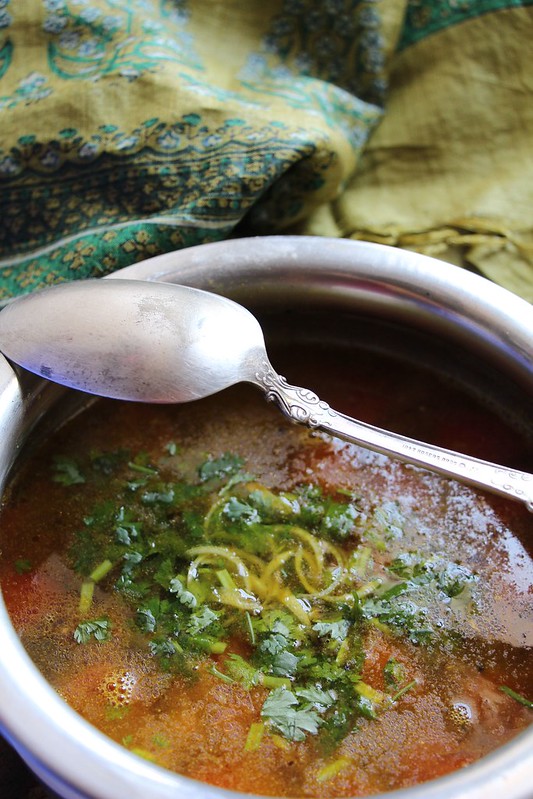
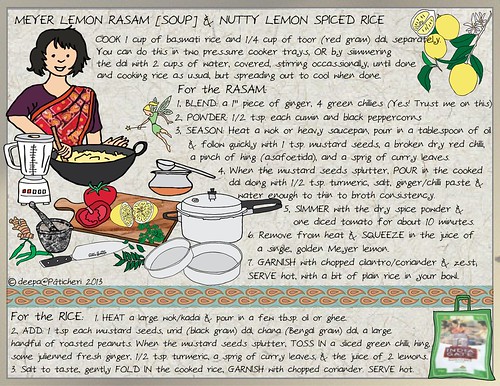
Leave a Reply